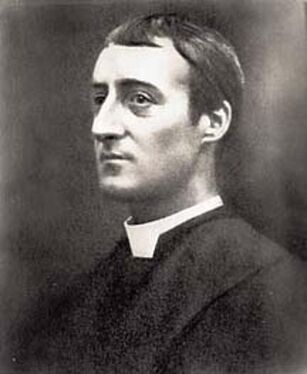
Gerard Manley Hopkins (1844-1889). Courtesy Louie, Louie.
| Gerard Manley Hopkins | |
|---|---|
| Born |
July 28 1844 London, England |
| Died |
June 8 1889 (aged 44) Dublin, Ireland |
| Resting place | Glasnevin Cemetery, Dublin |
| Occupation | Jesuit priest, Professor of Classics |
| Education | Balliol College, Oxford |
| Notable work(s) | Poems (1918) |
Rev. Gerard Manley Hopkins, S.J. (July 28, 1844 - June 8, 1889) was an English poet, Roman Catholic convert, and Jesuit priest, whose posthumous 20th-century fame established him among the leading Victorian poets. His experimental explorations in prosody (especially sprung rhythm) and his use of imagery established him as a daring innovator in a period of largely traditional verse.
Life[]
Family, youth, early education[]
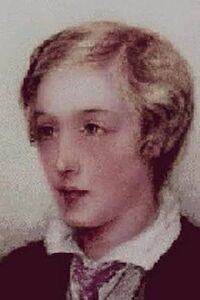
Hopkins as a boy, painted 24 July 1866. Courtesy Wikimedia Commons.
Hopkins was born in Stratford, East London, the oldest of 8 children of Catherine (Smith) and Manley Hopkins.[1] His father founded a marine insurance firm and for a time,was the British consul general in Hawaii. He was also, for a time, the church warden at St John-at-Hampstead and a published writer whose works included A Philosopher's Stone, and other poems (1843), Pietas Metrica (1849), and Spicelegium Poeticum: A gathering of verses by Manley Hopkins (1892). He reviewed poetry for The Times and wrote a novel. Catherine (Smith) Hopkins was the daughter of a London physician, particularly fond of music and of reading, especially German philosophy, literature and the novels of Dickens. Both parents were deeply religious High Church Anglicans.
Catherine's sister, Maria Smith Giberne, taught her nephew Gerard to sketch. The interest was supported by his uncle, Edward Smith; his great-uncle, professional artist Richard James Lane; and many other family members. [1] Hopkins's original ambition was to be a painter, and he would continue to sketch throughout his life, inspired, as an adult, by the work of John Ruskin and the Pre-Raphaelites.[2][1] Hopkins became a skilled draughtsman and found that his early training in visual art supported his later work as a poet.[1]
His siblings were greatly inspired by language, religion and the creative arts. Milicent (1849-1946) joined an Anglican sisterhood in 1878. Kate (1856-1933) would go on to help Hopkins publish the first edition of his poetry. Hopkins' youngest sister Grace (1857-1945) set many of his poems to music. Lionel (1854-1952) became a world-famous expert on archaic and colloquial Chinese. Arthur (1847-1930) and Everard (1860-1928) were both highly successful artists. Cyril (1846-1932) would join his father's insurance firm.[2]
In 1852 Manley Hopkins moved his family to Hampstead,, near to where John Keats had lived 30 years before and close to the wide green spaces of Hampstead Heath.
At age 10 Gerard was sent to board at Highgate School (1854-1863) [1] and, while studying Keats's poetry, composed "The Escorial" (1860), his earliest poem extant. Here he practised early attempts at asceticism. He once argued that most people drank more liquids than they really needed and bet that he could go without drinking for a week. He persisted until his tongue was black and he collapsed at drill. On another occasion, he abstained from salt for a week.[2][3]
Oxford[]
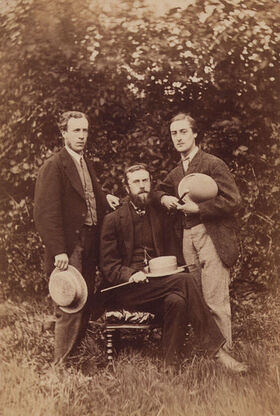
Alfred William Garrett, William Alexander Comyn Macfarlane and Gerard Manley Hopkins (left to right) by Thomas C. Bayfield 1866. Courtesy National Portrait Gallery (London) and Wikimedia Commons.
At Balliol College, Oxford (1863-67) Hopkins studied classics.[4] He was an unusually sensitive student and poet, as witnessed by his class-notes and early poetic pieces.
At Oxford he forged a lifelong friendship with Robert Bridges (eventual Poet Laureate of the United Kingdom) which would be of importance in his development as a poet, and his posthumous acclaim. [4] Hopkins was deeply impressed with the work of Christina Rossetti and she became a great contemporary influence, meeting him in 1864.[5] During this time he studied with writer and critic Walter Pater.[2]
Hopkins began his time in Oxford as a keen socialite and prolific poet, but he seemed to have alarmed himself with the changes in his behaviour that resulted, and he became more studious and began recording his "sins" in his diary.
It was during this time of intense scrupulousness that Hopkins seems to have begun confronting his strong homoerotic impulses[6] and began to consider choosing the cloister. As an undergraduate he engaged in friendships that may be viewed as romantic, though they tended to be idealized and spiritualized. In particular, he found it hard to accept his sexual attraction to other men, including a deep infatuation for Digby Mackworth Dolben. There is nothing, however, to suggest any physical intimacy, and indeed Hopkins seems to have remained celibate throughout his life. He exercised a strict self-control in regard to his homosexual desire, especially after he became a follower of Henry Parry Liddon and of Edward Pusey, the last member of the original Oxford Movement. [5]
On 18 January 1866 Hopkins composed his most ascetic poem, The Habit of Perfection. On 23 January he included poetry in the list of things to be given up for Lent. In July he decided to become a Catholic, and he traveled to Birmingham in September to consult the leader of the Oxford converts, John Henry Newman. [5] Newman received him into the Church on 21 October 1866. On 5 May 1868 Hopkins firmly "resolved to be a religious." Less than a week later, he made a bonfire of his poems and gave up poetry almost entirely for seven years. The decision to convert estranged him from both his family and a number of his acquaintances. After his graduation in 1867 Hopkins was provided a teaching post at The Oratory School by Newman, but the following year he decided to enter the priesthood, pausing only to visit Switzerland, which officially forbade Jesuits to enter.[2][6]
Priesthood[]

Gerard Manley Hopkins - To Seem a Stranger - documentary
Hopkins began his novitiate in the Society of Jesus at Manresa House, Roehampton, in September 1868 and moved to St. Mary's Hall, Stonyhurst, for his philosophical studies in 1870. In 1874 he returned to Manresa House to teach classics.
Writing would remain something of a concern for him as he felt that his interest in poetry prevented him from wholly devoting himself to his religion. However, after reading Duns Scotus in 1872, he saw that writing and religion did not necessarily conflict.[7] He continued to write a detailed prose journal between 1868 and 1875. Unable to suppress his desire to describe the natural world, he also wrote music, sketched, and for church occasions wrote some "verses," as he called them. He would later write sermons and other religious pieces.
While he was studying in the Jesuit house of theological studies, St Beuno's, near St Asaph in North Wales, he was asked by his religious superior to write a poem to commemorate the foundering of a German ship in a storm. So in 1875 he was moved to take up poetry once more and write a lengthy poem, The Wreck of the Deutschland. This work was inspired by the Deutschland incident, a naval disaster in which 157 people died including 5 Franciscan nuns who had been leaving Germany due to harsh anti-Catholic laws. The work displays both the religious concerns and some of the unusual meter and rhythms of his subsequent poetry not present in his few remaining early works. It not only depicts the dramatic events and heroic deeds but also tells of the poet's reconciling the terrible events with God's higher purpose. The poem was accepted but not printed by a Jesuit publication, and this rejection fuelled his ambivalence about his poetry. Most of his poetry remained unpublished until after his death.
Hopkins chose the austere and restrictive life of a Jesuit and was at times gloomy. The brilliant student who had left Oxford with a 1st class honours degree failed his final theology exam. This failure almost certainly meant that, though ordained in 1877, Hopkins would not progress in the order. In 1877 he wrote God's Grandeur, an array of sonnets including The Starlight Night,and finished The Windhover only a few months before his ordination. Though rigorous, isolated and sometimes unpleasant, his life during Jesuit training had at least some stability; the uncertain and varied work after ordination was even harder on his sensibilities.
In October 1877, not long after he completed "The Sea and the Skylark" and only a month after he had been ordained as a priest, Hopkins took up his duties as subminister and teacher at Mount St. Mary's College, Chesterfield. In July 1878 he became curate at the Jesuit church in Mount Street, London. In December he became curate at St. Aloysius's Church, Oxford, then moving to Manchester, Liverpool and Glasgow.[2] Whilst ministering in Oxford he became a founding member of Oxford University Newman Society, a society established in 1878 for the Catholic members of Oxford University. He taught Greek and Latin at Mount St Mary's College, Sheffield, and Stonyhurst College, Lancashire.
In 1884 he became professor of Greek literature at University College Dublin. His English roots and his disagreement with the Irish politics of the time, as well as his own small stature (5'2"), unprepossessing nature and personal oddities meant that he was not a particularly effective teacher. This as well as his isolation in Ireland deepened his gloom and his poems of the time, such as I Wake and Feel the Fell of Dark, reflected this. They came to be known as the "terrible sonnets," not because of their quality but because according to Hopkins's friend Canon Dixon, they reached the "terrible crystal," meaning that they crystallized the melancholy dejection which plagued the later part of Hopkins' life.
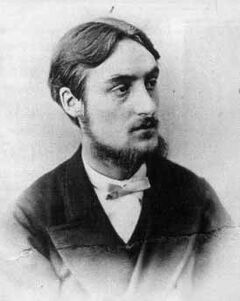
Hopkins in later life. Courtesy Wikimedia Commons.
Final years[]
Several problems conspired to depress Hopkins's spirits and restrict his poetic inspiration during the last 5 years of his life.[8] His work load was extremely heavy. He disliked living in Dublin, away from England and friends. His general health deteriorated as his eyesight began to fail. He felt confined and dejected. As a devout Jesuit, he found himself in an artistic dilemma. To subdue any egotism which would violate the humility required by his religious position, he decided never to publish his poems. But Hopkins realized that any true poet requires an audience for criticism and encouragement. This conflict between his religious obligations and his poetic talent caused him to feel that he had failed them both.
After suffering ill health including and bouts of diarrhea for several years, Hopkins died of typhoid fever in 1889. He was buried in Glasnevin Cemetery, following his funeral in Saint Francis Xavier Church on Gardiner Street in Georgian Dublin. He is thought to have suffered throughout his life from what today might be diagnosed as either bipolar disorder or chronic unipolar depression, and battled a deep sense of melancholic anguish. However, on his death bed his last words were "I am so happy, I am so happy. I loved my life,"[3]
Writing[]
Sprung rhythm[]
- Main article: Sprung rhythm

Hopkins and Sprung Rhythm
Much of Hopkins's historical importance has to do with the changes he brought to the form of poetry, which ran contrary to conventional ideas of meter. Prior to Hopkins, most Middle English and Modern English poetry was based on a rhythmic structure inherited from the Norman side of English literary heritage. This structure is based on repeating groups of 2 or 3 syllables, with the stressed syllable falling in the same place on each repetition. Hopkins called this structure "running rhythm", and though he wrote some of his early verse in running rhythm he became fascinated with the older rhythmic structure of the Anglo-Saxon tradition, of which Beowulf is the most famous example. Hopkins called his own rhythmic structure "sprung rhythm." Sprung rhythm is structured around feet with a variable number of syllables, generally between one and four syllables per foot, with the stress always falling on the first syllable in a foot. In reality, it more closely resembles the "rolling stresses" of Robinson Jeffers, another poet who rejected conventional metre. Hopkins saw sprung rhythm as a way to escape the constraints of running rhythm, which he said inevitably pushed poetry written in it to become "same and tame." In this way, Hopkins can be seen as anticipating much of free verse. His work has no great affinity with either of the contemporary Pre-Raphaelite and neo-romantic schools, although he does share their descriptive love of nature, and he is often seen as a precursor to modernist poetry or as a bridge between the 2 poetic eras.
Use of language[]
The language of Hopkins's poems is often striking. His imagery can be simple, as in Heaven-Haven, where the comparison is between a nun entering a convent and a ship entering a harbour out of a storm. It can be splendidly metaphysical and intricate, as it is in As Kingfishers Catch Fire, where he leaps from one image to another to show how each thing expresses its own uniqueness, and how divinity reflects itself through all of them.
He uses many archaic and dialect words, but also coins new words. One example of this is twindles, which seems from its context in Inversnaid to mean a combination of twines and dwindles. He often creates compound adjectives, sometimes with a hyphen (such as dapple-dawn-drawn falcon) but often without, as in rolling level underneath him steady air. This concentrates his images, communicating the instress of the poet's perceptions of an inscape to his reader.
Hopkins took time to learn Old English, which became a major influence on his writing. Hopkins held the language in such high regard that in an 1882 letter to Robert Bridges, he opines that Old English is "a vastly superior thing to what we have now".[9]
Added richness comes from Hopkins's extensive use of alliteration, assonance, onomatopoeia and rhyme, both at the end of lines and internally as in:
As kingfishers catch fire, dragonflies draw flame;
As tumbled over rim in roundy wells
Stones ring; like each tucked string tells, each hung bell's
Bow swung finds tongue to fling out broad its name;
I caught this morning morning's minion, king-
dom of daylight's dauphin, dapple-dawn-drawn Falcon, in his riding
Of the rolling level underneath him steady air, and striding
High there, how he rung upon the rein of a wimpling wing
In his ecstasy! then off, off forth on swing,
As a skate's heel sweeps smooth on a bow-bend: the hurl and gliding
Rebuffed the big wind. My heart in hiding
Stirred for a bird, the achieve of, the mastery of the thing!
Hopkins was influenced by the Welsh language that he acquired while studying theology at St Beuno's College near St Asaph. The poetic forms of Welsh literature and particularly cynghanedd with its emphasis on repeating sounds accorded with his own style and became a prominent feature of his work. This reliance on similar sounding words with close or differing senses mean that his poems are best understood if read aloud. An important element in his work is Hopkins's own concept of "inscape" which was derived, in part, from the medieval theologian Duns Scotus. The exact detail of "inscape" is uncertain and probably known to Hopkins alone but it has to do with the individual essence and uniqueness of every physical thing. This is communicated from an object by its "instress" and ensures the transmission of the item's importance in the wider creation. His poems would then try to present this "inscape" so that a poem like "The Windhover" aims to depict not the bird in general but rather a single instance and its relation to the breeze..[3]
During his lifetime, Hopkins published few poems. It was only through the efforts of Robert Bridges that his works were seen. Despite Hopkins burning all his poems on entering the Jesuit novitiate, he had already sent some to Bridges who, with a few other friends, was one of the few people to see many of them for some years. After Hopkins's death they were distributed to a wider audience, mostly fellow poets, and in 1918 Bridges, by then poet laureate, published a collected edition; an expanded edition, prepared by Charles Williams, appeared in 1930, and a greatly expanded edition by W.H. Gardiner appeared in 1948 (eventually reaching a 4th edition, 1967, with N.H. Mackenzie).
Notable collections of Hopkins's manuscripts and publications are in Campion Hall, Oxford; the Bodleian Library, Oxford; and the Foley Library at Gonzaga University in Spokane, Washington.
Erotic influences[]
Some contemporary critics believe that Hopkins's suppressed erotic impulses played an important role in the tone, quality and even content of his works. These impulses seem to have taken on a degree of specificity after he met Robert Bridges's distant cousin, friend, and fellow Etonian Digby Mackworth Dolben, "a Christian Uranian".[11] Hopkins biographer Robert Bernard Martin asserts that when Hopkins met Dolben, on Dolben's 17th birthday, in Oxford in February 1865, it "was, quite simply, the most momentous emotional event of [his] undergraduate years, probably of his entire life".[12] Hopkins was completely taken with Dolben, who was nearly 4 years his junior, and his private journal for confessions the following year proves how absorbed he was in imperfectly suppressed erotic thoughts of him.[13]
Hopkins kept up a correspondence with Dolben, wrote about him in his diary and composed 2 poems about him, "Where art thou friend" and "The Beginning of the End." Robert Bridges, who edited the first edition of Dolben's poems as well as Hopkins's, cautioned that the second poem "must never be printed," though Bridges himself included it in the first edition (1918).[14] Another indication of the nature of his feelings for Dolben is that Hopkins's High Anglican confessor seems to have forbidden him to have any contact with Dolben except by letter. Their relationship was abruptly ended by Dolben's drowning in June 1867, an event which greatly affected Hopkins, although his feeling for Dolben seems to have cooled a good deal by that time. "Ironically, fate may have bestowed more through Dolben's death than it could ever have bestowed through longer life ... [for] many of Hopkins's best poems - impregnated with an elegiac longing for Dolben, his lost belovèd and his muse - were the result."[15]
Some of his poems, such as The Bugler's First Communion and Epithalamion, arguably embody homoerotic themes, and he has been associated recently with the Uranian poets, whose writings derived, in many ways, from the prose works of Walter Pater, Hopkins's academic coach for his Greats exams, and later his lifelong friend.[16][17][18]
Some critics have argued that homoerotic readings are either highly tendentious, or, that they can be classified under the broader category of "homosociality," over the gender, sexual-specific "homosexual" term. Hopkins's journal writings, they argue, offer a clear admiration for feminized beauty. In his book Hopkins Reconstructed (2000) Justus George Lawler critiques Robert Martin's controversial biography Gerard Manley Hopkins: A Very Private Life (1991) by suggesting that Martin "cannot see the heterosexual beam... for the homosexual biographical mote in his own eye... it amounts to a slanted eisegesis". The poems that elicit homoerotic readings can be read not merely as exercises in sublimation but as powerful renditions of religious conviction, a conviction that caused strain in his family and even led him to burn some of his poems that he felt were unnecessarily self-centered. Julia Saville's book A Queer Chivalry views the religious imagery in the poems as Hopkins's way of expressing the tension with homosexual identity and desire. The male figure of Christ allows him to safely express such feelings, which mitigates the political implications.
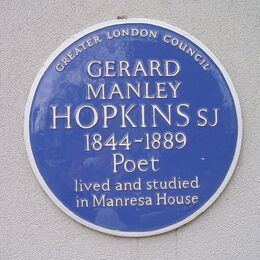
Hopkins blue plaque, Roehampton, London. Photo by Carcharoth. Licensed under Creative Commons, courtesy Wikimedia Commons.
Recognition[]
On 8 December 1975, a memorial stone to Hopkins was unveiled in Poets' Corner, Westminster Abbey.[19]
In popular culture[]
An example of Hopkins's influence can be heard in the song "Bright Wings" by industrial-metal-hyper-soul band Mortal on their 1993 CD release Fathom. The song is an abbreviated version of Hopkins's poem "God's Grandeur".
Publications[]
Poetry[]
- Poems (edited by Robert Bridges),. London: Milford, 1918. (audio)
- enlarged (edited by Robet Bridges & Charles Williams), London: Oxford University Press, 1930
- enlarged again (edited by W.H. Gardner) London & New York: Oxford University Press, 1948
- revised (edited by W.H. Gardner), London & New York: Oxford University Press, 1956
- enlarged again (edited by W.H. Gardner & N.H. MacKenzie), London & New York: Oxford University Press, 1967
- corrected (edited by W.H. Gardner & N.H. MacKenzie), London & New York: Oxford University Press, 1970.
Prose[]
- Sermons and Devotional Writings (edited by Christopher Devlin). London & New York: Oxford University Press, 1959.
- "Winter with the Gulf Stream," Once a Week, 8 (February 1863): 210.
- "Barnfloor and Winepress," Union Review, 3 (1865); 579-580.
Letters and journals[]
- Notebooks and Papers (edited by Humphry House), London & New York: Oxford University Press, 1937
- enlarged as Journals and Papers (edited by Humphry House & Graham Storey), London & New York: Oxford University Press, 1959.
- Further Letters (edited by Claude Colleer Abbott). London: Oxford University Press, 1938
- revised & enlarged, London: Oxford University Press, 1955.
- Letters to Robert Bridges (edited by Claude Colleer Abbott). London: Oxford University Press, 1955.
- Correspondence of Gerard Manley Hopkins and Richard Watson Dixon (edited by Claude Colleer Abbott). London: Oxford University Press, 1955.
Except where noted, bibliographical information courtesy the Poetry Foundation.[20]
Audio / video[]

"God's Grandeur" by Gerard Manley Hopkins (Favorite Poem Project)

Richard Burton reads Gerard Manley Hopkins' poem 'The Leaden Echo & The Golden Echo'.

As Kingfishers Catch Fire, Dragonflies Draw Flame by Gerard Manley Hopkins (poetry reading)

Gerard Manley Hopkins - The Windhover
- Richard Austin reads Hopkins' poetry in Back to Beauty's Giver.[21]
Poems by Gerard Manley Hopkins[]
See also[]
References[]
- Abbot, Claude Coller (Ed.), 1955. The Correspondence of Gerard Manley Hopkins and Richard Watson Dixon (London: Oxford University Press.)
- Abbot, Claude Coller (Ed.), 1955. The Letters of Gerard Manley Hopkins to Robert Bridges (London: Oxford University Press.)
- Fiddes, Paul S., 2009. 'G.M. Hopkins', in Rebecca Lemon, Emma Mason, Jonathan Roberts, and Christopher Rowland, eds, The Blackwell companion to the Bible in English literature (Blackwell companions to religion, Chichester: Wiley-Blackwell), pp. 563-576
- MacKenzie, Norman H. (Ed.), 1989. The Early Poetic Manuscripts and Note-books of Gerard Manley Hopkins in Facsimile. (New York and London: Garland Publishing.)
- MacKenzie, Norman H. (Ed.), 1991 The Later Poetic Manuscripts of Gerard Manley Hopkins in Facsimile (New York: Garland Publishing.
- Martin, Robert Bernard, 1992. Gerard Manley Hopkins - A Very Private Life (London: Flamingo/HarperCollins Publishers)
- Sagar, Keith, 2005. "Hopkins and the Religion of the Diamond Body", in Literature and the Crime Against Nature, (London: Chaucer Press.)
- Stiles, Cheryl, 2010. "Hopkins-Stricken: Gerard Manley Hopkins, a Selective Bibliography." (Berkeley Electronic Press).
- White, Norman, 1992. Hopkins - A literary Biography (Oxford: Oxford University Press)
Notes[]
- ↑ 1.0 1.1 1.2 1.3 1.4 Gardner, W.H. (1963) Gerard Manley Hopkins: Poems and prose Penguin pxvi
- ↑ 2.0 2.1 2.2 2.3 2.4 2.5 Poetry Foundation Biography accessed 2010-03-18
- ↑ 3.0 3.1 3.2 Eleanor Ruggles (1944) Gerard Manley Hopkins: a life. Norton.
- ↑ 4.0 4.1 Gardner, W.H. (1963) Gerard Manley Hopkins: Poems and Prose Penguin pxvii
- ↑ 5.0 5.1 5.2 Gardner, W. H. (1963) Gerard Manly Hopkins: Poems and Prose Penguin pxviii
- ↑ 6.0 6.1 P. Kitchen, Gerard Manley Hopkins, London, 1978
- ↑ Gerard Manley Hopkins: A Brief Biography Glenn Everett, Ph. D.
- ↑ Gardner, W. H. (1963) Gerard Manly Hopkins: Poems and Prose Penguin pxxvii
- ↑ Brook, George Leslie (1955). An Introduction to Old English, page 1. Manchester University Press.
- ↑ - The Windhover
- ↑ Timothy d'Arch Smith. Love in Earnest, p. 188)
- ↑ Gerard Manley Hopkins: A Very Private Life, p. 80; see also Norman White, Hopkins: A Literary Biography, p. 110)
- ↑ Robert Bernard Martin, "Digby Augustus Stewart Dolben," DNB)
- ↑ Joseph Cady English Literature: Nineteenth Century
- ↑ Kaylor, Michael M. Secreted Desires: The Major Uranians: Hopkins, Pater and Wilde. Brno, CZ: Masaryk University Press, 2006. p401
- ↑ The Bugler's First Communion, Kaylor, Secreted Desires. pp 182-93
- ↑ Epithalamion in Kaylor Secreted Desires, pp 161-205
- ↑ Victorian Poetry 40.2 (2002), pp 157-87
- ↑ Gerard Manley Hopkins, People, History, Westminster Abbey. Web, July 11, 2016.
- ↑ Gerard Manley Hopkins 1844–1889, Poetry Foundation, Web, Nov. 26, 2011.
- ↑ Audio book, CD, ISBN 0-9548188-0-6, 2003. 27 poems, including The Wreck Of The Deutschland, God's Grandeur, The Windhover, Pied Beauty and Binsley Poplars, and the 'Terrible Sonnets'.
External links[]
- Poems
- Gerard Manley Hopkins in the Oxford Book of English Mystical Verse: "The Habit of Perfection," "God's Grandeur," "Mary Mother of Divine Grace, compared to the Air we breathe"
- 4 poems by Hopkins: "Hurrahing in Harvest," "Look at the Stars!," " Spring," "The May Magnificat"
- Gerard Manley Hopkins profile & 11 poems at the Academy of American Poets
- Hopkins, Gerard Manley (1844-1889) (18 poems) at Representative Poetry Online
- Gerard Manley Hopkins 1844–1889 at the Poetry Foundation
- Gerard Manley Hopkins at PoemHunter (79 poems)
- Gerard Manley Hopkins at AllPoetry (87 poems)
- Audio/video
- Poems of Gerard Manley Hopkins at LibriVox
- Profile and poems (written and video) at the BBC
- Gerard Manley Hopkins at YouTube
- Books
- Works by Gerard Manley Hopkins at Project Gutenberg
- Gerard Manley Hopkins at Amazon.com
- Works by or about Gerard Manley Hopkins in libraries (WorldCat catalog)
- About
- Gerard Manley Hopkins in the Encyclopædia Britannica
- Gerard Manley Hopkins at NNDB
- Gerard Manley Hopkins in the Catholic Encyclopedia
- Gerard Manley Hopkins on the Victorian Web
- Gerard Manley Hopkins links at LiteraryHistory.com
- Gerard Manley Hopkins at St Beuno's retreat
| This page uses Creative Commons Licensed content from Wikipedia. (view article). (view authors). |
|